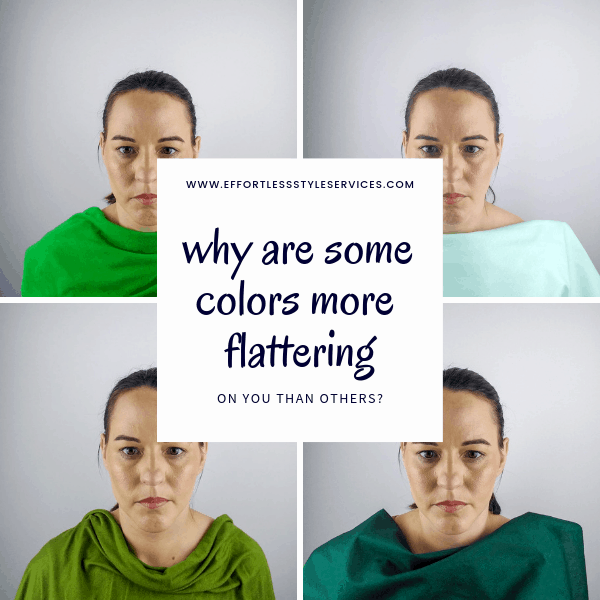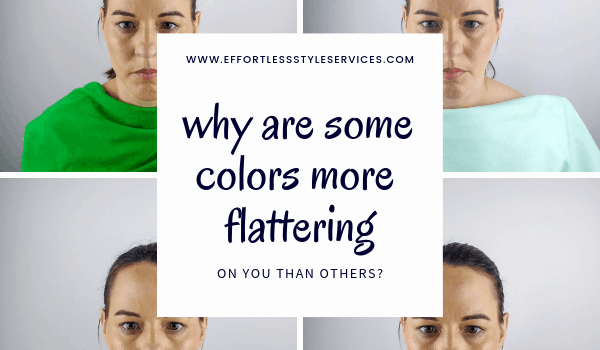
In a nutshell, your most flattering colors are determined by the natural coloring of your body— your, skin, your hair and your eyes. We’re going to go a little deeper and peel back the layers of the shell. We’ll start with your skin.
Peeling back the layers of the shell
Skin
Undertone
Your skin, in itself, is comprised of different elements. Everyone’s skin has an undertone to it. We refer to this as being either warm or cool. The cool undertone has a blue base and the warm undertone has a red or yellow undertone. Scientifically, the undertone of the skin is determined by the transparency of the skin and how much of the blood underneath shows through. The more pigment in the skin, the less visible the colors are underneath. Bernice Kentner explains it very well in her book,
Color Me a Season: A Complete Guide to Finding Your Best Colors and How to Use Them
Overtone
Overtones are are different than undertones and are often blemishes and things that we’d like to minimize like splotches, dark spots, acne and acne scars and other discolorations.
Tone or depth
The tone is the depth of the color of our skin with the lightest being a fair complexion ranging to a deep skin tone that is very dark.
Skin tone Identification
Pantone has created a remarkable system for identifying skin tones. They scientifically measured thousands of skin tones and came up with 110 skin tones. The Skin Tone Guide has assigned each color a specific code. The code consists of 4 digits. The first two characters identify where the color lies on a scale of cool to warm. The cool tones range from 1R to 5R and the warm tones range from 1Y to 5Y with 1 being the least warm or cool and 5 being the greatest. Then the depth of color is designated from 01 to 15 with 01 being the lightest and 15 being the darkest.
In conjunction with this new Pantone system, Sephora is providing a service called Color IQ. This service uses a device to scan the surface of your skin to determine the exact (or closest) Pantone color from the Pantone Skin Tone Guide. Then Sephora can provide a list of foundations and cosmetics that are perfectly suited to your skin tone. Click here for a list of Sephora locations. If you don’t know if you’re cool or warm toned, or if you struggle to find the correct foundation shade, this is a great option for you. Finding the correct cosmetic colors is of huge importance to maintaining harmony in the colors of your complexion.
Colors as camouflage

When we wear a color on our body with the correct undertone to match our skin, it has the same effect as applying foundation to cover the shadows and other imperfections on our face— though maybe not to as strong of a degree.
The color we wear around our face is reflected back onto the face. If the undertone of the color is the same as the undertone of our skin, it diminishes or reduces the appearance of overtones or blemishes on our skin. That’s why seasonal color theory works.
Why would you ever want to wear anything but your most flattering colors. By reflecting the right colors onto our face, we’re camouflaging or blending away our flaws. When wearing the right colors for our complexion, we can reduce the appearance of dark circles under the eyes, fine lines, acne, scars, dark spots and other blemishes. By reducing the shadows, the more flattering colors can actually visually lift the face and make you look younger and more vibrant. That’s why the undertone of the clothing you choose to wear is so important. There are other important qualities of color that have an impact on your complexion as well like its intensity and value.
YOU- your most valuable asset
The ultimate goal of getting dressed is to showcase you. Not cover you up and overpower you. The focus is to be you.
Essentially, that’s where intensity and value come into play. I like to think of it in a manner of contrast. If you have a high contrast in the natural colors in your body, you will look better in colors with a high contrast and the same goes for the opposite, low contrast looks better on those with low contrast in the natural pigments in your body. That’s why changing your hair color or getting a tan can change or broaden the spectrum of colors that flatter you. It’s also equally important that you don’t change your natural coloring outside of your range. Individuals with a cool undertone should always stick to hair colors with an “ash” undertone and those with warm undertones should go with colors with a “golden” undertone.

I’d say as a general rule of thumb, don’t go lighter than the lightest color your hair ever was as a child— that includes those summers you spent 95% of your day out in the pool.
Also remember, you had the sun kissed skin to go with it. That bleached blonde doesn’t have the same effect on your complexion if you are now mostly confined to indoors. Don’t go much darker than the dark ring around your iris. If the ring around your iris is blue or another color that is not a natural hair color, go with one the same value. (think of a black and white photo). Sometimes it might take a little bit of playing around to find the right hair color if you decide you want to change what you’ve been naturally given.
Determining your best colors
When deciding your most flattering colors, it’s most important to notice the effects the color has on your skin. If you radiate confidence in a certain color, that’s probably a solid indication. Ultimately, the best way to determine your most flattering colors is to be draped by a professional color analyst. For those of you in the 73533, visit my services page to book a color consultation. Everyone else get on the waiting list for my FREE Color Course.
See my color draping above? Which color do you think I look best in? 1, 2, 3, or 4? Leave your response in the comments below.
Finally, follow my Color Board on Pinterest for more information to help you pinpoint your most flattering colors.



